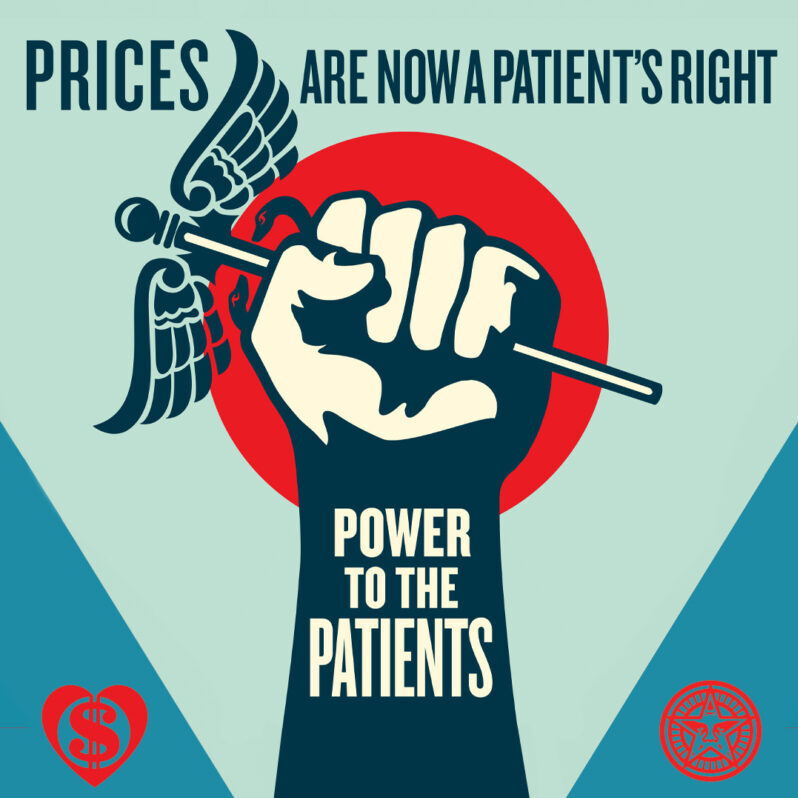When the Super Bowl rolls around each year, some people care more about the mega-expensive ads than the game itself.
While the LA Rams came out on top, the consensus winners of the advertising competition seem to be Uber Eats, Flamin’ Hot Doritos, and Google Pixel 6. It’s the one time of year that viewers look forward to commercials instead of hitting fast-forward. And the prices reflect that; a 30-second spot cost a record-breaking $6.5 million.
A lot less expensive, but perhaps more important, were ads flying above Los Angeles as part of the Power to the Patients campaign leading up to the big game. Featuring artwork by Shepard Fairey (who did the famous Obama Hope poster), they promoted price transparency in health care. One version of the ad says, “Prices are now a patient’s right. Demand them!” Another version uses the tagline “Demand Hospital Prices.”
Behind the bold graphics was a public policy reality: hospitals are now required to disclose their prices, thanks to a federal rule that took effect in January 2021. The rule requires hospitals to publish online the standard charges for their services, providing the information in two ways: (1) machine-readable files for all hospital services and (2) consumer-friendly displays of 300 common “shoppable” services. The rule is imperfect, but it’s a start on lifting the veil of secrecy that has long shadowed health care pricing and left consumers in the dark.
Yet, multiple analyses have found that compliance is low and that true transparency remains elusive. A new report found that only 14.3% of hospitals nationwide were complying with transparency requirements. And compliance was only 0.5% among hospitals that are part of the nation’s three largest hospital systems.
To be fair, the rule took effect at an especially trying time for hospitals. Given the enormous strain of the COVID-19 pandemic, it’s not surprising that implementing price transparency measures hasn’t been many hospitals’ top priority. And the penalties for noncompliance have been quite weak. As of December 2021, the Centers for Medicare & Medicaid Services had issued only 335 warning notices to hospitals that hadn’t adequately implemented the rule. Those warnings outlined specific issues for hospitals to address, but none included a financial penalty. (The rule allowed for penalties of up to $300 per day in 2021 for noncompliance — a relatively tiny amount, particularly for larger hospitals — although that daily maximum increased to $5,500 this year for hospitals with more than 30 beds.)
No rule is going to work without adequate enforcement. But levying fines will also only get us so far. Using a different lens that focused on whether hospitals were embracing the spirit if not the letter of the transparency rule, Manatt Health (with support from the New York Health Foundation) recently examined New York hospitals’ compliance and concluded that most had made incremental progress. That analysis found that 69% of New York’s hospitals had only partially implemented the requirements for machine-readable information, while 69% had implemented the shoppable services requirement.
The Manatt report also highlights examples of effective approaches to price transparency that can serve as models for hospitals that may be further behind in implementation. The most effective examples of machine-readable files were those that made it easy for a broad range of audiences (including researchers, data aggregators, app developers, and other hospitals, as well as consumers) to find pricing information that is comprehensive, accurate, and comparable across the industry. For example, many hospitals provide a single Excel file with a single Excel sheet inclusive of the required information, separated by columns; this approach makes it easy for the information to be used, sorted, shared, and compared. In the case of shoppable services, the most effective implementation included a consumer-friendly online price estimator tool to help individual consumers shop for services based on price. These are easy to find on a hospital’s website; ask the user simple, plain-language questions to guide them in their search; and provide clear estimates of a consumer’s expected out-of-pocket costs for the specified service.
Beyond the technicalities, what matters is hospitals’ desire to embrace the spirit of the law and not simply the letter of the law. Providers should want their patients to have meaningful information so they can make smart choices that provide value for money. And it’s possible. I’ve written before that “Where There’s a Will There’s a Way.” Even before the new rule took effect, pioneering hospitals were sharing price information in meaningful ways and meeting many of the requirements. Early adopters recognize that the most frequent “pain points” for patients at hospitals involve their financial experiences, and they believe that patients who know the price ahead of time are more likely to pay.
I’ve also said this before: health care transparency alone isn’t going to bring down health care costs or fix a broken system. It isn’t a magic bullet and there are serious limitations: a lot of care isn’t shoppable, the ways that prices are presented to consumers aren’t comprehensible, high prices might be used by some as an inaccurate proxy for quality, information has to be paired with financial incentives, and some people are in insurance arrangements that make them immune to the need for price information.
But information is power, and we should continue to demand more and better transparency in health care. Secrecy has been monetized — to the detriment of the consumer. A reckoning in health care is coming — perhaps its own kind of Super Bowl, where providers who deliver high-quality care at fair and transparent prices will come out on top.
By David Sandman, President and CEO, New York Health Foundation
Published in Medium on February 17, 2022

